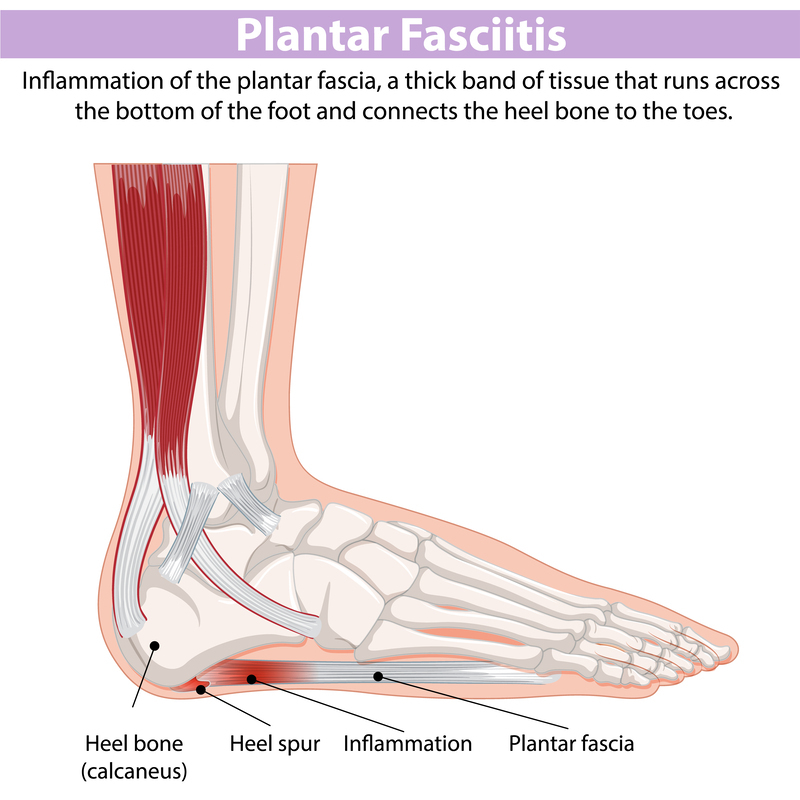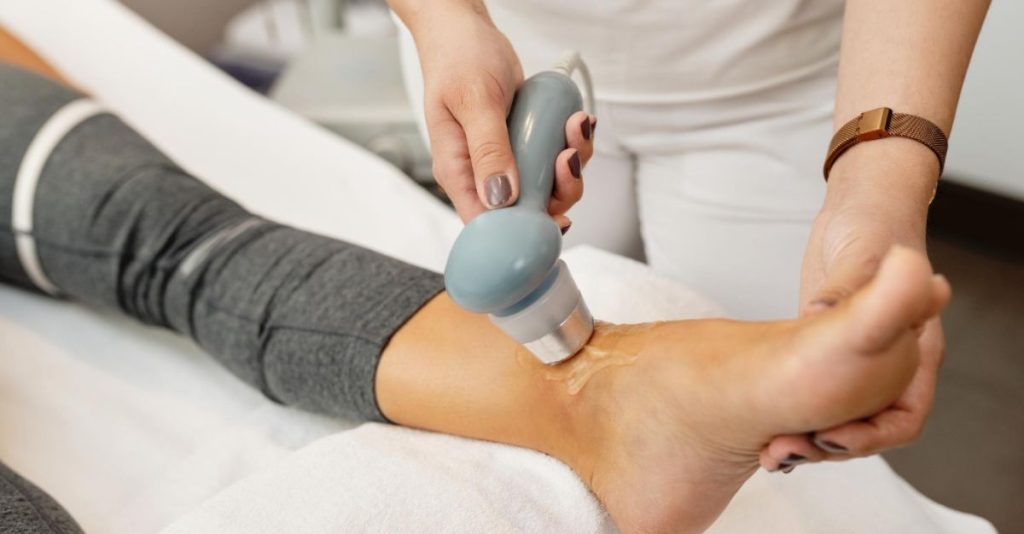Struggling with heel pain that just won’t go away? It could be plantar fasciitis – a foot condition that affects many Malaysians and makes everyday movement uncomfortable.
While many people confuse it with a heel spur, understanding the key differences between heel spur vs plantar fasciitis is crucial for effective treatment.
This article looks into what causes the condition, how the treatment works, and why it may be suitable for those living with ongoing heel pain.
Key Takeaways
- Plantar fasciitis is the inflammation of the plantar fascia, often caused by prolonged standing, high-impact activities, or poor footwear.
- While often confused, heel spurs are bone growths, whereas plantar fasciitis is tissue inflammation, with the latter being the primary source of pain.
- Shockwave therapy treats plantar fasciitis by using acoustic waves to improve blood flow, stimulate natural healing, and reduce pain signals.
- The main types of shockwave therapy for plantar fasciitis are Focused (precise, deeper) and Radial (broader, shallower) applications.
- Shockwave therapy offers significant benefits, including being non-invasive, requiring no downtime, and providing effective pain relief by accelerating natural healing.
- The number of shockwave therapy sessions typically ranges from 3 to 5, depending on the severity and individual response.
Plantar Fasciitis Explained: Understanding Your Heel Pain

Plantar fasciitis occurs when the plantar fascia, a thick band of tissue along the bottom of your foot, becomes inflamed.
This ligament connects the heel to the toes and plays an important role in absorbing impact and supporting the arch during movement.
The National Institutes of Health (NIH) reported that plantar fasciitis is estimated to account for 11% to 15% of all foot symptoms requiring professional medical care among adults globally.
This condition is usually caused by repeated stress on the tissue, which leads to tiny tears and irritation. This strain can happen for several reasons, such as:
| Category | Specific Cause | Description |
| Overuse/Strain | Prolonged Standing | Spending long hours on your feet, especially on hard surfaces, increases stress on the plantar fascia. |
| High-Impact Activities | Sports like running, dance, and aerobics involve repetitive impact that can strain the ligament. | |
| Biomechanical | Poor Footwear | Shoes lacking adequate arch support, cushioning, or with worn-out soles fail to support the foot properly. |
| Foot Mechanics | Flat feet (pes planus) or unusually high arches (pes cavus) can alter weight distribution and strain. | |
| Tight Calf Muscles or Achilles Tendon | Limited ankle flexibility due to tightness in these areas can increase tension on the plantar fascia. | |
| Lifestyle/Weight | Obesity | Excess body weight places significant additional load and stress on the plantar fascia. |
Heel Spur vs. Plantar Fasciitis: Know the Difference

Often confused, heel spurs and plantar fasciitis are distinct.
A calcaneal spur (known as heel spur) is an abnormal bony growth on the heel while plantar fasciitis is the inflammation of the plantar fascia tissue on the bottom of your foot.
Crucially, the pain you feel is almost always from the inflamed plantar fascia, not the bone spur itself. Many have spurs without pain, and vice-versa.
Here’s how they differ:
| Feature | Heel Spur | Plantar Fantasciis |
| Nature | Bone growth/calcification | Inflammation of soft tissue |
| What It Is | A bony protrusion on the heel bone | Inflammation of the plantar fascia ligament |
| Cause of Pain | Rarely the direct cause of pain itself; often asymptomatic. | The primary cause of heel pain due to tissue irritation and microtears. |
| Development | Develops over time from chronic tension/stress where the plantar fascia attaches to the heel bone. | Develops from acute or chronic stress, overuse, or foot strain on the plantar fascia. |
| Diagnosis | Confirmed by X-ray (visible bone growth). | Diagnosed clinically based on symptoms and physical examination; X-ray may show a spur but confirms inflammation. |
| Treatment Focus | Not typically treated directly unless very large and problematic; addresses underlying plantar fascia issues. | Focuses on reducing inflammation, pain, and improving plantar fascia health. |
Unlocking Relief: How Shockwave Treatment for Heel Pain Works

Shockwave therapy treats heel pain by delivering acoustic pulses to the affected area.
These waves stimulate the body’s natural repair process by improving blood flow, which delivers essential nutrients for healing.
The treatment also works to break down problematic calcium deposits and reduce inflammation, promoting healthy tissue regeneration and restarting the healing process in chronic conditions.
This comprehensive action ultimately leads to pain relief.
Get all the details about what is shockwave therapy and understand the shockwave therapy cost to see how it can help you.
Choosing Your Healing Path: Types of Shockwave Therapy for Plantar Fasciitis

To treat heel pain, some clinics use focused shockwave therapy, while others use radial. They don’t work the same way.
Focused therapy reaches deeper into the tissue. Radial therapy works more on the surface.
Which one works best depends on where and how severe the pain is.
| Feature | Focused Shockwave Therapy (FSWT) | Radial Shockwave Therapy (RSWT) |
| Wave Type | High-energy, precisely focused acoustic waves | Lower-energy, radially dispersing pressure waves |
| Penetration | Deeper (up to 12cm) | Shallower (up to 3-4cm) |
| Energy Density | Concentrated at focal point | Highest at skin surface, disperses inwards |
| Targeting | Precise, for specific deep pathologies/calcifications | Broader area, for more diffuse or superficial issues |
| Best for Plantar Fasciitis | Chronic, stubborn cases, calcifications, deep fascia damage | More superficial pain, broader muscular/fascial work |
5 Key Benefits of Shockwave Therapy for Plantar Fasciitis

Shockwave therapy offers a compelling solution for persistent heel pain, standing out due to its numerous advantages over more invasive options.
Accelerating natural healing, shockwave therapy leads to significant results, with studies showing up to 96.4% improvement in heel pain and 75.3% of patients being “complaint-free” in long-term follow-ups.
It’s a highly valued treatment for plantar fasciitis for several key reasons:
1. Gentle on the Body
Shockwave therapy doesn’t involve cutting or medication. It’s done on the surface of the skin, keeping the process simple and easy to tolerate.
2. Back on Your Feet Immediately
You don’t have to set aside time for recovery. Most people walk out of their session and carry on with the rest of their day. If there’s any soreness, it’s usually light and goes away quickly.
3. Relief That Lasts
Many feel a clear drop in pain not long after starting treatment. It helps calm overactive nerves, which gives the body a better chance to recover and stay pain-free.
4. Supports Body Healing Process
Shockwave therapy boosts blood circulation, encourages collagen growth, and helps break down stubborn scar tissue. These effects support tissue repair and target the actual source of the pain, rather than just the symptoms.
5. Optimised with Swiss DolorClast® Technology
The Swiss DolorClast® system is widely respected for its precision. Its advanced design ensures consistent, focused delivery of shockwaves for effective results.
This technology is clinically proven to provide optimal energy transfer, ensuring consistent and effective treatment sessions that maximise therapeutic outcomes for conditions like plantar fasciitis.
Explore our detailed comparison of TECAR vs Shockwave therapy to see which might be right for you.
How Often to Take Shockwave Therapy When Needed?
If plantar fasciitis doesn’t improve with rest, stretching, insoles, or medication, shockwave therapy may be the next step.
It’s often recommended if you’ve experienced persistent plantar fasciitis pain for 6 to 12 months without significant improvement from methods like rest, stretching, orthotics, or medication.
Additionally, it becomes a strong consideration if the heel pain is severe enough to significantly impact your daily life, limiting your ability to walk, stand, or perform routine activities.
Experience Targeted Relief with Chiropractic House: Your Solution for Plantar Fasciitis
For those seeking effective shockwave therapy in Kepong for plantar fasciitis, advanced treatment is available, elevating care through the use of EMS Swiss DolorClast® Shockwave Therapy. This cutting-edge technology ensures precise and powerful acoustic wave delivery, crucial for healing and pain relief.
The approach emphasises customised treatment plans, recognizing the unique nature of each patient’s condition. Our experienced chiropractic in Kepong professionals and certified therapists craft tailored solutions, ensuring the therapy precisely addresses your specific plantar fasciitis needs.
This personalised care, combined with a commitment to the latest shockwave technology, aims to break down scar tissue, reduce inflammation, and accelerate the natural healing of the plantar fascia, providing effective relief from persistent heel pain.
Got nagging aches? Learn when to see a chiropractor and take the first step towards lasting relief.
Conclusion
Some foot problems take time to heal, but when the pain doesn’t ease, shockwave therapy can help.
It’s a non-invasive method used to relieve stubborn heel pain like plantar fasciitis, without needing surgery or time off your feet.
Ready to take the step towards a pain-free life? Book your session with Chiropractic House for advanced Swiss DolorClast® technology and expert care can help you find lasting relief.




